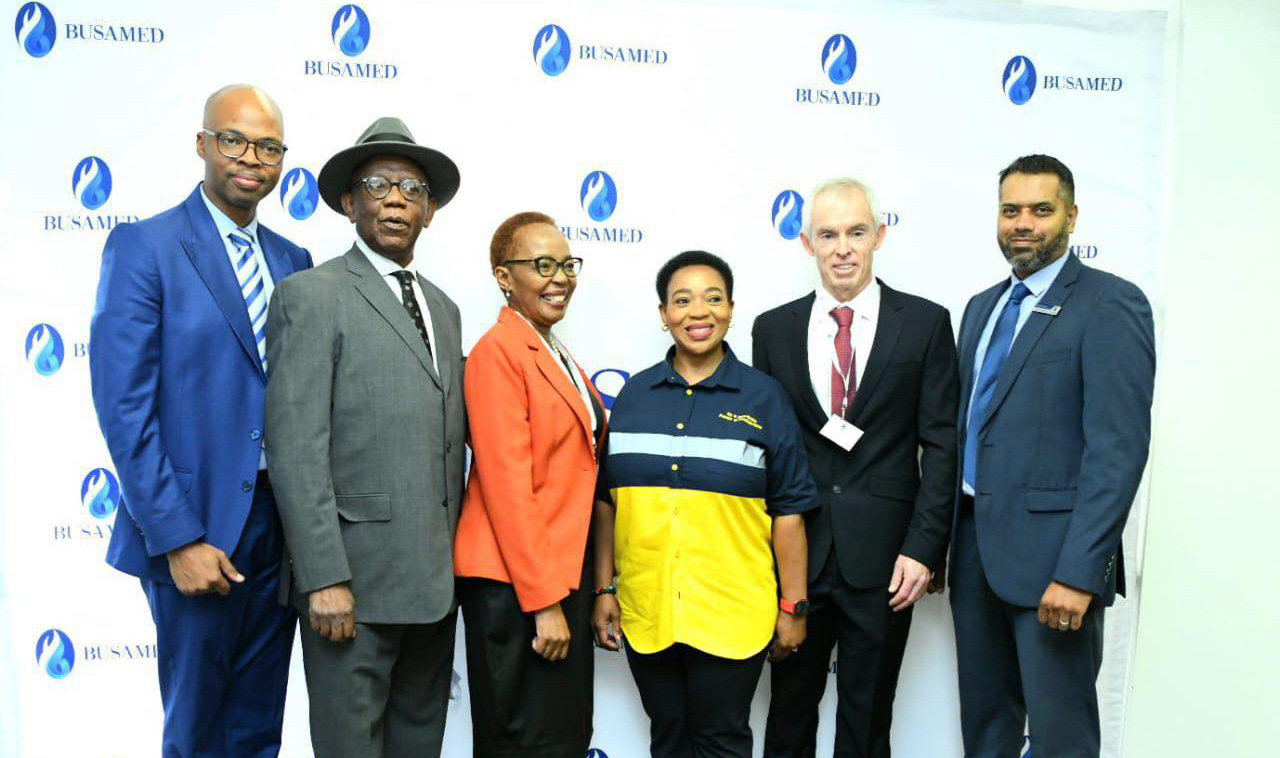
While many of us take the benefits of a healthy spine for granted, spinal pain is a sharp reminder of how much we depend on our backs in daily life. Busamed Modderfontein Orthopaedic Surgeon specialising in spinal surgery, Dr Lusanda Bomela is a renowned surgeon, who utilises a multimodal approach to holistically treat spinal patients.
Dr Bomela is also currently the only female Spine Surgeon who is AO Spine Fellowship (an internationally recognised fellowship) trained at UCT-GSH, which positions her as an ideal healthcare professional to manage and share education on spine related care, conditions and surgery.
As part of the World Spine Day awareness campaign, Dr Bomela shared some insight into the importance of caring for your spine not only on World Spine Day, but every day.
“What is spine health? What is spine agronomics? What are the things that you can do to ensure that you take care of your spine? These are the important things we need to speak about and know.
“The spine is important because it carries you, it is what enables you to have your mobility so you can imagine something as essential as that needs to be taken care of. You must be aware of how to take care of the spine so that it has longevity. Longevity and good spine health will then ensure that you are less likely to have early symptoms of back pain, neck pain, even arthritic pain. The spine is also related to your hip movement and knee movement. So, if you take care of that, you also decrease the chance of having early arthritis in those other areas.”
Speaking about how you should take care of your spine, Dr Bomela offers research-based pointers to adequately care for your spine.
“The most important one is mobility and exercise. It has been found that mobility and weight bearing exercises decrease the occurrence of stiffness, back pain and debilitating symptoms. Most of the spinal disorders are inflammatory in nature. So, you have degeneration, different types of arthritis, inflammation and pathology which causes a pain cascade thus limiting mobility and function. If you prophylactically, take care of yourself by being mobile and perform weight bearing exercise, it has been found that it produces anti-inflammatory effects which improve the pain, function and mobility.”
She noted that this allows a person to move and overcome the symptoms of back pain, neck pain, or whatever spinal pain they are experiencing.
“For predisposed patients, which many patients are, because there is a genetic link between arthritis and families, you know that you are at least delaying the onset of the spinal disorder. Brisk walking, jogging, running, and climbing where you put weight on your spine, hips, and knees have been found to be useful.”
Dr. Bomela believes that if a patient is suffering from chronic pain, workouts such as water aerobics can be beneficial.
“If you put weight on the actual spine, you produce anti-inflammatory agents, which is what we want. When patients come to me, they will get prescribed medication that includes anti-inflammatories, but you can get anti-inflammatories naturally by exercising. This is what we are attempting to achieve.”
She explains the importance of real bone quality, which includes taking care of your bones and examining your nutrition.
“Calcium is essential for bone formation, bone mass and bone strength. Calcium can be found in dairy products as well as supplements for patients who cannot tolerate dairy products., in which case we recommend supplements. Vitamin D is crucial in aiding calcium absorption. Vitamin D is obtained from sunlight exposure as well as fish like salmon, cheese and egg yolks.”
She says that because of people’s modern lifestyles and jobs, acquiring vitamin D naturally has grown increasingly difficult.
“We are finding there’s an increase in patients who have vitamin D deficiency, which can be combated by spending 10-30 minutes in direct sunlight several times per week.”
She advises adopting practical methods to get enough sunlight.
“One of the things I tell patients to make it more practical is an actual example of what I do when I drop my kids off at school. I wait in my car facing the sun for 15-20 minutes after dropping them off to check emails or catch up on other work. I’ve then received my vitamin D for the day and can go about my business.”
Vitamin K and magnesium, she states, also have a role in calcium absorption at a cellular level.
“It’s all interrelated with the metabolism of calcium. Calcium does not work in isolation. You need vitamin K and magnesium for the calcium to get out of the tissues and to get to the bones. You can get all these nutrients from your diet, especially from green vegetables and from supplements.”
Dr. Bomela also mentioned the caveat of obesity within the sphere of food.
“There is a direct link between obesity and early osteoarthritis, causing back and neck problems. It has been found in research that if a person can drop at least 10- 15% of their body weight, it makes a difference to the health of their spine, hips, and knees. So, if you weigh 100 kilograms, the minimum you need to lose is at least 10 -15 kilograms to feel the health effects. It makes a difference if patients can take care of themselves and ensure that they are mobile, eating well, and eating healthily.”
Concerning the “working” patient, Dr. Bomela stated that the sort of work that patients do has a significant impact on their spinal health. “The nature of the task is critical. What do you do while doing the work? So, for example, in our day and age, many people do administrative job. They’re either at work or at home, at the dining room table, with their laptops. So, there’s already a lot that may go wrong.”
She advises that spinal ergonomics has a major role to play when it comes to the health of the spine.
“Ergonomics is the study of the work environment as it relates to the worker. So, the chair is vital for someone who is sitting. Ergonomic chairs are chairs that conform to the curvatures of the spine since the spine curves differently at the neck, upper back, lower back, and buttock. As a result, this type of chair follows and supports the spine. If you’re going to be sitting for extended periods of time, you’ll need a chair that supports your spine. The position of the buttock, hips, knees and ankles are also important when sitting at a desk for prolonged periods. There are several distinct sorts of ergonomic chairs.”
“The height of the desk is critical when sitting in this chair. So, if you’re sitting in a chair, the height of the desk should be just right so that you’re not slouching. There’s also the computer, which, if you’re using a standard desktop, should be at least at eye level. If you’re using a laptop, you’ll need to raise the computer so that everything you’re looking at is at least at eye level, rather than with your head bowed down, as many people do.”
She believes that the way a person sits, stands, and bends is essential.
“When you sit, your shoulders should be up, your back should be against the chair, and your buttocks should slouch down. When the buttocks sag, the knees rise, relieving pressure on the lower spine.”
“That’s just one example, but I also treat my colleagues and advise them of a few things to take note of. For example, in theatre, what’s very important is the height of the table, the chair that they’re sitting on, if they’re doing an operation sitting down, if they’re standing, where they’re standing, how they’re standing, how far are they from the table, which side, and at what angle, are they using instruments or machines such as laparoscopes, fluoroscopy or microscopes? The type of instruments utilised is also critical because you need instruments that are easy to grip but are friendly to the operation position so as to prevent muscle fatigue in the neck and lower back.
“If you’re talking about someone doing manual labour, they need to know how to bend, how to lift heavy things, how to position their knees, back, hips, knees and their back, when performing manual intense heavy duty labour. These are the precautionary measures that we discuss while performing consultations with patients.”
In terms of spinal kinematics, she explains that the hips and knees must bend so that there is less strain on the back, and they must be aligned and adjacent to each other.
“To ensure that the weight is distributed evenly, your ankles must be aligned, and your feet must be apart. Because your spine is a tripod, you want to shift the pressure from the back to the front, so that your abdomen bears the majority of the weight.”
Hence the importance of core strengthening via physiotherapy, biokinetics, Pilates, yoga and abdominal core exercises.
“You change the tripod weight distribution; you change the spinal core dynamics, and this leads to back or neck pain.”

Dr Lusanda Bomela
Orthopaedic surgery,
Busamed Modderfontein
You may also be interested in:

April 15, 2024
New Busamed partnership delivers hope

April 3, 2024


